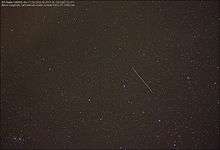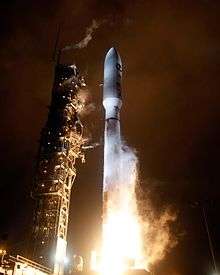Future Imagery Architecture
Future Imagery Architecture (FIA) was a program to design a new generation of optical and radar imaging US reconnaissance satellites for the National Reconnaissance Office (NRO). In 2005 NRO director Donald Kerr recommended the project's termination, and the optical component of the program was finally cancelled in September 2005 by Director of National Intelligence John Negroponte. FIA has been called by The New York Times "perhaps the most spectacular and expensive failure in the 50-year history of American spy satellite projects."[1] Despite the optical component's cancellation, the radar component, known as Topaz, has continued, with four satellites in orbit as of February 2016.

History

In 1999 the development contract for FIA was awarded to a Boeing team, which underbid Lockheed Martin's competing proposal by about US$1 billion (inflation adjusted US$ 1.53 billion in 2019).[2][3] By 2005, an estimated US$10 billion had been spent by the US government on FIA, including Boeing's accumulated cost overrun of US$4 to 5 billion,[4] and it was estimated to have an accumulated cost of US$25 billion over the ensuing twenty years.[5] In September 2005 the contract for the electro-optical satellites was shifted to Lockheed Martin because of the cost overruns and delays of the delivery date.[6] Lockheed was asked to restart production of KH-11 Kennen satellite system with new upgrades.[1] The contract for the imaging radar satellite remained with Boeing.[1] In September 2010 NRO director Bruce Carlson stated that while most NRO "(...) programs are operating on schedule and on cost (...)", one program is "(...) 700 percent over in schedule and 300 percent over in budget".[7]
The exact scope and mission of FIA are classified, although the head of the NRO said in 2001 that the project would focus on creating smaller and lighter satellites.[8] Some industry experts believe that a key objective is to make the satellites more difficult to attack, possibly by placing them in higher orbits. Because of the large size of the program, as well as number of workers involved, some experts have compared it to the 1940s Manhattan Project.[8]
In 2012 NRO donated two sophisticated but unneeded space telescopes, reportedly built for FIA, to NASA for use in astronomy.[9]
Launches
The first operational FIA Radar satellite, USA-215 or NROL-41,[10] was launched on 21 September 2010. It is in a retrograde 1100 x 1105 km orbit inclined by 123 degrees,[11] an orbital configuration indicating it is an SAR satellite.[10] On 3 April 2012, a second satellite, USA-234 or NROL-25, was launched into a similar orbit.
The earlier USA-193 satellite, launched in 2006, is believed to have been a technology demonstration satellite intended to test and develop systems for the FIA radar programme.[12] However, it failed immediately after launch, and was subsequently destroyed by a missile.
Spacecraft
| Name | COSPAR ID SATCAT No. |
Launch date (UTC) |
Launch vehicle | Launch site | Launch designation | Orbit | Decay date | Remarks |
|---|---|---|---|---|---|---|---|---|
| USA-215 | 2010-046A 37162 | 21 September 2010 04:03:30 | Atlas V 501 | VAFB SLC-3E | NROL-41 | 1,102 km x 1,105 km x 123° | in orbit | |
| USA-234 | 2012-014A 38109 | 3 April 2012 23:12:57 | Delta IV M+(5,2) | VAFB SLC-6 | NROL-25 | ~1,100 km x ~1,100 km x 123° | in orbit | |
| USA-247 | 2013-072A 39462 | 6 December 2013 07:14:30 | Atlas V 501 | VAFB SLC-3E | NROL-39 | 1,108 km x 1,113 km x 123°[13] | in orbit | |
| USA-267 | 2016-010A 41334 | 10 February 2016 11:40:32 | Delta IV M+(5,2) | VAFB SLC-6 | NROL-45 | 1,077 km x 1,086 km x 123.0°[14] | in orbit | |
| USA-281 | 2018-005A 43145 | 12 January 2018 22:10 | Delta IV M+(5,2) | VAFB SLC-6 | NROL-47 | 1,048 km x 1,057 km x 106°[15] | in orbit |
Successor program
USA-224, launched on 20 January 2011, is believed to be the first of the large post-FIA optical reconnaissance satellites built by Lockheed.[16]
The failed FIA program is to be succeeded by the Next Generation Electro-Optical (NGEO) program. NGEO is intended as a lower-risk modular system, which is capable of being modified incrementally over its lifetime.[17]
References
- Philip Taubman (November 11, 2007). "In Death of Spy Satellite Program, Lofty Plans and Unrealistic Bids". The New York Times. Retrieved May 3, 2010.
- "Boeing Team Wins Future Imagery Architecture". Archived from the original on November 12, 2006. Retrieved May 20, 2007.
- "Future Imagery Architecture [FIA] - Phase C". Global Security.
- "Future Imagery Architecture [FIA] - 2005 Restructuring". Global Security.
- Pae, Peter. "Massive Spy-Satellite Program to Cost Billions Archived 2007-06-09 at the Wayback Machine", Los Angeles Times, March 18, 2001. Retrieved October 10, 2006.
- Charles P. Vick. "Future Imagery Architecture". globalsecurity.org.
- Bruce Carlson (2010-09-13). "National Reconnaissance Office Update" (PDF). Air & Space Conference and Technology Exposition 2010. Archived from the original (PDF) on 2010-12-06. Retrieved 2010-11-25.
- Sullivan, Laura. "A peek into secrets most jealously guarded", Baltimore Sun, September 8, 2001. Retrieved October 10, 2006.
- Ferster, Warren (2012-06-08). "Donated Space Telescopes are Remnants of Failed NRO Program". SpaceNews. Retrieved 2013-05-31.
- "SeeSat-L Sep-10 : Updated elements". SeeSat-L. 2010-09-24. Retrieved 2016-02-16.
- "SeeSat-L Oct-10 : Updated elements". SeeSat-L. Retrieved 2016-02-16.
- John Pike. "FIA - RADSAT Spacecraft Family". Globalsecurity.org. Retrieved 2016-02-16.
- Peat, Chris (22 January 2015). "USA 247 - Orbit". Heavens-Above. Retrieved 25 January 2015.
- Peat, Chris (12 February 2016). "USA 267 - Orbit". Heavens-Above. Retrieved 13 February 2016.
- Langbroek, Marco (22 January 2018). "TOPAZ/FIA Radar 5, the NROL-47 payload". SatTrackCam Leiden. Retrieved 27 January 2018.
- "SeeSat-L Jan-11 : NROL-49 search elements". Satobs.org. 2011-01-20. Retrieved 2016-02-16.
- Dr. Bruce Berkowitz (September 2011). "The National Reconnaissance Office At 50 Years: A Brief History" (PDF). Center for the Study of National Reconnaissance. Archived from the original (PDF) on 2011-10-15. Retrieved 2011-10-24.